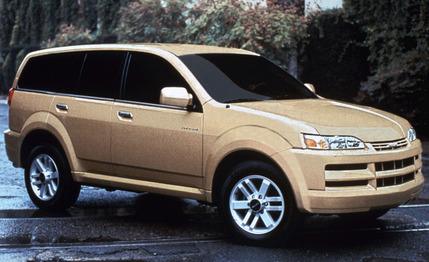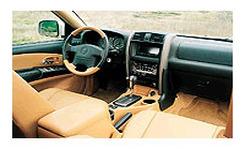 First Drive Review
First Drive Review
A crossover isn't quite the same thing as a cross-dresser, but even so there are a lot of them around these days, and Isuzu is about to expand the category again.
Crossover vehicles are those neither/nor creations that don't quite fit the sport-utility-vehicle category but aren't likely to be confused with passenger cars, either. The Pontiac Aztek is a crossover vehicle, although not an ideal example since the Aztek cannot be confused with anything. So let's point to the Audi Allroad and the Lexus RX300, since both are singled out by Isuzu as competitors to its new Axiom. And they also help to illustrate our next point.
Aside from its singular styling, the Axiom brings one other distinction to the expanding world of crossovers: It's the only body-on-frame design in the hunt; all the others are unit-body vehicles based on the bones of front-drive passenger cars or minivans. The Axiom, in contrast, is essentially a truck -- body and frame are mated late in the final assembly process.
There are lots of excellent reasons for going the unit-body route in this realm of sport-utilities that are unlikely to see hard off-road service -- having a higher chassis rigidity and a lower curb weight are foremost among them. So why, you may ask, is Isuzu swimming upstream? Simple. Isuzu is a truck specialist. It's been eight years since the company offered a passenger car in the U.S., which means it had no car-parts bin to reach into. Thus, the Axiom's eye-catching epidermis is wrapped around Rodeo bones -- the same box-section ladder-type frame, with the same 106.4-inch wheelbase and the same track: 59.6 inches front and 59.8 inches rear. The suspension layout is basically the same -- independent up front with unequal-length control arms and torsion bars; a five-link, coil-sprung live-axle setup at the rear; and anti-roll bars at each end -- although Isuzu has updated its Intelligent Suspension Control (ISC) system for this application. Like other so-called semiactive suspension systems, ISC is governed by a computer that monitors vehicle speed, engine rpm, cornering force, shock-absorber loading, and brake operation to provide real-time adjustments through a range of 17 different damping levels in two different modes -- comfort and sport. Although sport is the stiffer of the two, the distinctions are subtle. As a colleague observed, "It's hard to tell, but there seems to be more sport in the sport setting than comfort in the comfort mode."

Other shared Rodeo hardware includes the variable-assist (variability determined by engine rpm) rack-and-pinion steering system, and the brakes -- front disc and rear drum in two-wheel-drive editions, all disc in four-wheel-drivers, with anti-lock brakes standard. Also shared is the optional Torque-on-Demand (TOD) four-wheel-drive system, first introduced in 1998 on the Isuzu Trooper. Like some other systems -- the one used in the Ford Explorer, for example -- Isuzu's TOD is an automatic system that transfers up to 50 percent of the engine's torque to the front wheels when wheelspin is detected at the rear. Unlike the all-wheel-drive systems common to crossovers such as the Allroad and the RX300, Isuzu's TOD includes a two-speed transfer case, with a low range for creepy-crawly work.